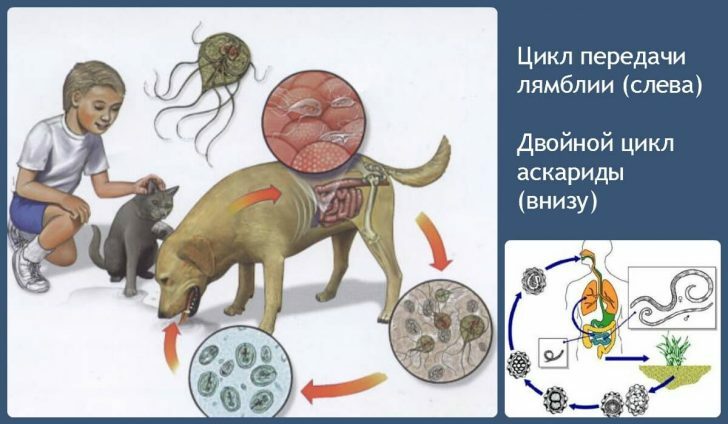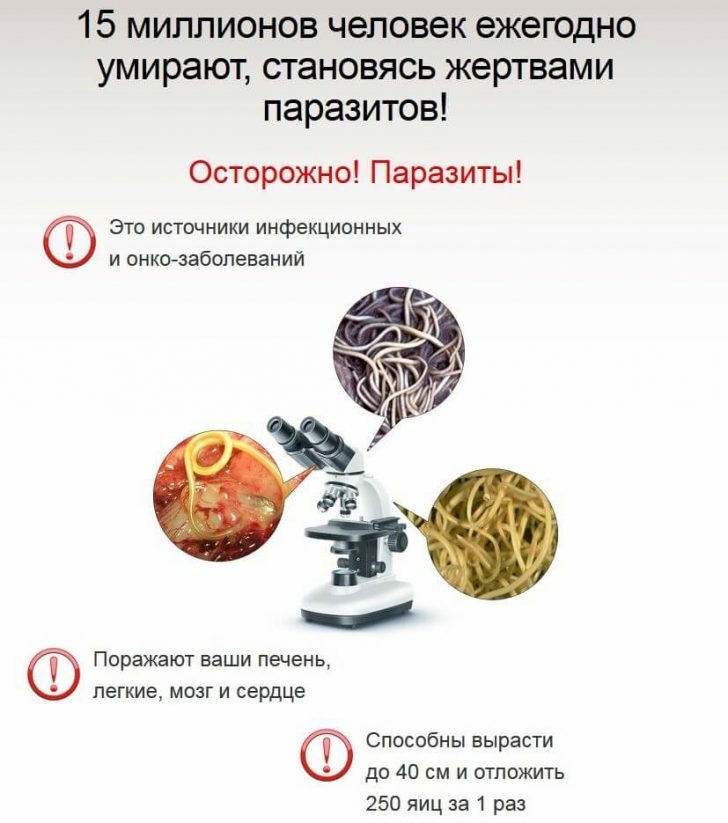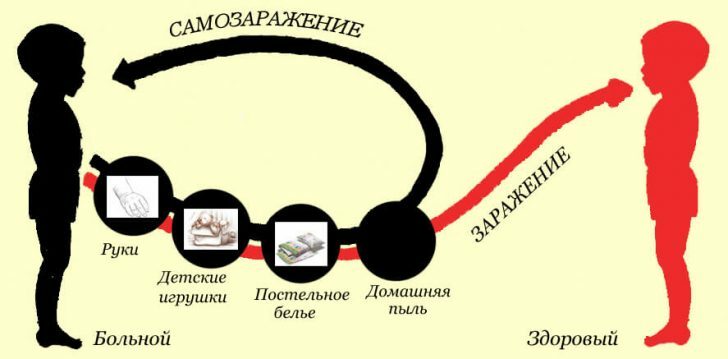Wide tapeworm: symptoms in humans, photos, causes, treatment
Diphyllobothriasis (broad tapeworm) is a parasitic infection caused by the entry into the human body of an individual from the order Diphyllobothrium latum. The broad tapeworm penetrates the intestines through infected fish.
Quite a dangerous disease, as the parasite can reach a length of several meters and by its existence causes enormous damage to human health.
Content
- Vital activity of the parasite
- Reasons for infection
- Factors contributing to infection
- Symptoms
- Diagnostics
- Consequences of a parasite infection
- Treatment
- Drug treatment
- Surgery
- Complementary home treatments
- Herbs
- Pumpkin seeds with carrots
- Pumpkin seeds with milk
- Recovery period
- Prophylaxis
- Forecast
- Related Videos
Vital activity of the parasite
The broad tapeworm has a rather long life span, during the period of which more than one owner changes.
First, the parasite's egg enters a freshwater reservoir, where it transforms into a larva. It is called the coracidium. The transformation process takes 1 month. The larva lives in the reservoir for a week, where it is swallowed by a small crustacean - daphnia.
In the body of the coracidium crustacean there is 2 weeks and changes to a procercoid. Then the crustacean, which contains the parasite, is swallowed by the fish. Inside it, daphnia decomposes and the larva is released, where it transforms into a plerocercoid.
The larva is located throughout the body, the highest concentration is found in muscle tissue, eggs and liver.
The final development of the broad tapeworm takes place in humans in the body, getting there when eating infected fish.
Reasons for infection
It is possible to become infected with diphyllobothriasis only through intermediate hosts - fish.
The larvae living in water bodies do not pose any danger to humans.

But fish are a direct threat. A person can get a wide ribbon even through ordinary tactile contact with it (cleaning). And also when ingested.
Factors contributing to infection
- insufficiently fried fish;
- raw fish;
- lightly salted fish;
- cutting fish and tactile interaction with it;
- poorly washed hands after cutting fish.
Symptoms

After penetration parasite into the body and its active growth, the following signs appear in a person, talking about infection:
- nausea occurs;
- there is a frequent urge to vomit;
- unpleasant and painful sensations in the gastrointestinal tract;
- stool disorders;
- deterioration or increase in appetite;
- hypersalivation;
- slight rise in temperature;
- changes in the nervous system (numbness of hands and legs, weak sensitivity);
- change in blood composition.
The first symptoms in humans appear after 20-60 days of the parasite's presence in the body.
If the broad tapeworm spends a long enough time inside the body (see. photo above), then such symptoms appear in a person as:
- feeling of weakness and fatigue;
- there is a blanching of the skin and mucous membranes;
- blood pressure drops;
- heart rate increases;
- headaches occur;
- dizziness and loss of consciousness.
Read also:Enterobiasis: causes, symptoms and treatment in adults and children
These are all signs anemia, which arises due to the lack of vitamin b (more precisely B12). It plays an important role in the production of hemoglobin. In addition, a decrease in the level of basophils and neutrophils. In addition, deficiencies in other important nutrients are common. This causes significant damage to human health.
Diagnostics
If a number of symptoms characteristic of this parasitic infection occur, first of all, the possibility of infection should be taken into account, namely, whether there was contact with the fish.
The following research methods are used to diagnose diphyllobothriasis:
- OCP examination of feces is considered the most informative way to detect a disease, but it has a rather high price;
- a smear is performed to detect the presence of eggs or segments of the broad tapeworm, which have a specific appearance. Feces are examined under a microscope;
- serological methods that are based on the detection of antibodies. These methods are of little informative nature.
In addition, diagnostics include studies such as:
- a blood test aimed at detecting anemia, an increased level ESR, eosinophilia, etc .;
- a biochemical blood test helps to detect a drop in the level of protein and albumin, elevated total bilirubin levels.
Consequences of a parasite infection
- due to the fact that the parasite is fixed on the mucous membranes of the intestine, subsequently, tissue necrosis and atrophic ulcers occur at the place of attachment of the tapeworm;
- there is a disorder of the gastrointestinal tract, because the parasite damages the nerve endings of the mucous membranes and the function of the intestines is disrupted;
- the products secreted by the broad tapeworm in the process of life lead to allergic reactions;
- anemia occurs due to a deficiency of vitamin B12, the level of which decreases due to the influence of the parasite.
Treatment
For the treatment of diphyllobothriasis, drugs are primarily used that provide for the destruction of the parasite. In addition, drugs are used to treat anemia.
Folk remedies are also effective in treating the disease.
Drug treatment

When detecting the presence of a wide tapeworm in the body, use a drug such as Biltricide.
The dosage should be prescribed by a doctor and, if necessary, it is adjusted.
The drug, acting on the parasite, paralyzes it, which leads to its death and exit. This drug has contraindications.
In addition, a number of other drugs are used against helminths, for example:
- Praziquantel - paralyzes the parasite. Can be used in children from 4 years of age;
- Niclosamide - used for children from 2 years old and adults;
- together with antiparasitic drugs use antihistamines, for example Suprastin, Tavegil.
Read also:Symptoms and treatment of nematodes in the human body
Iron and vitamin B12 preparations are also used (Cyanocobalamin) for the treatment of anemia. Also, preparations of probiotics and prebiotics are prescribed to normalize the intestinal microflora.
After 6 months, a second stool analysis, since the head of the parasite could remain in the body and begin to develop again. If necessary, the treatment is repeated.
Surgery
This disease does not provide for a surgical method of treatment.
Complementary home treatments
Some folk remedies help very well in the fight against a wide tapeworm. Home treatment should only be used as complementary methods. It includes the use of some remedies that have proven to be excellent in the fight against the disease. The most effective are pumpkin and fern.
Herbs

Male fern extract requires some preparation before consumption.
Per 2 days before taking the drug, you should follow a diet: do not eat fatty and spicy foods. Before starting treatment, you should drink a laxative at night.
In the morning on an empty stomach it is necessary to give an enema. Then he drinks the drug according to the scheme provided for by the age category.
After 30 minutes, you must take a laxative. And after 1h 30 minutes you can have breakfast, but the food should be light.
If during 3 hours there was no stool, then it is necessary to carry out a cleansing enema.
Another very effective remedy in the fight against broad tapeworm is pumpkin seeds. They are also recommended by doctors for those who cannot take medications due to contraindications and for children.
You will need 300 g of pumpkin seeds, which must be well chopped. Then you need to fill them with 50-60 ml of warm water. Take the resulting mixture in the morning on an empty stomach. After 3 hours, you must take a laxative. After that, after 30 minutes, carry out a cleansing enema.
Pumpkin seeds with carrots
For cooking, you need 3 tbsp. tablespoons of mashed carrots and 30 g of well-crushed pumpkin seeds. Season with 2 tbsp. tablespoons of vegetable oil.
The resulting product must be taken on an empty stomach, and after 1 hour and 30 minutes after taking, drink 1 tbsp. a spoonful of castor oil for a laxative effect. So the parasite will leave the patient's body.
Pumpkin seeds with milk
This remedy is used for children. You will need peeled and well-crushed pumpkin seeds, which are poured over with milk. The dose is calculated based on the age of the child.
This remedy is taken on an empty stomach. If the child does not drink milk. You can use honey instead.
You can have breakfast after treatment. After 3 hours, give the child 2 hours. Spoons of castor oil or olive oil.
Read also:Echinococcus: causes, symptoms and treatment in humans
You can also use collection. Required:
- 4 equal parts of flax seeds and tansy flowers;
- 2 parts chopped cloves
- 1 equal part of the herb of cumin, centaury, wormwood and crushed pumpkin seeds.
All components are well crushed and mixed. The course lasts 1 week according to the following scheme:
- 1 day - 1 hour a spoonful of collection on an empty stomach with water.
- Day 2 and 3 - the collection is taken twice: 1 time on an empty stomach in the morning, 2 times half an hour before lunch;
- From 3 to 7 days - you need to take the collection for 1 hour. spoon 3 times a day.
Home treatment with such methods should be carried out only after consulting a doctor.
Recovery period
Since the parasite causes serious damage to human health, after treatment, it is necessary to carry out a comprehensive recovery.
For example, you can use a collection of equal parts rose hips, black currants and raspberries. 1 hour a spoonful of collection is poured with 1 glass of boiling water and insisted for 1 hour. Take 100 ml of infusion 3-4 times a day.
You can also use linen. It will take 1 tbsp. a spoonful of flax seeds, which must be poured with 1 cup of boiling water. Insist for 2 hours. Take 50 ml 3 times a day. This infusion helps to restore the intestinal mucous membranes.
Prophylaxis
Prevention of infection provides for the observance of some rules that will help to avoid illness and unpleasant consequences due to the parasite;
- carefully examine the fish for the presence of parasites;
- purchase fish products only at trusted retail outlets;
- heat the fish for 30-40 minutes;
- filling the fish should take at least 10 days;
- fish must be kept frozen;
- observe personal hygiene (wash hands thoroughly, use clean dishes);
- timely medical examinations of workers in the fish processing industry;
- observance of sanitary standards on ships and improvement of river reservoirs where fish are caught.
Forecast
The prognosis of recovery is favorable when all the doctor's recommendations are followed. But after recovery, a rather weak immunity is developed and therefore re-infection with diphyllobothriasis is possible.
The main thing that leads to a quick recovery is a timely visit to a doctor who will conduct an examination and prescribe treatment.
Experts do not recommend self-medication, since it is ineffective in the fight against parasites and can only aggravate the situation.



